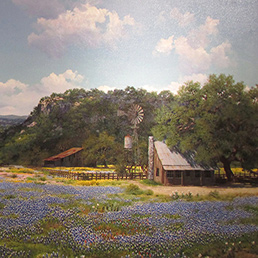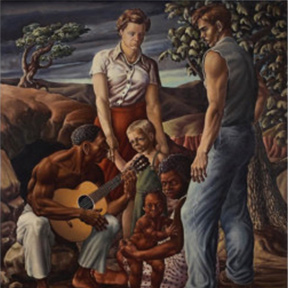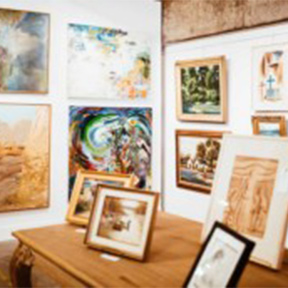- (214) 720-4044
- info@daviddike.com
- Mon - Fri: 10 am - 5 pm
Kelpe, Paul
Paul Kelpe
(AM. 1902-1985)
A German artist whose signature painting is abstraction based on constructivism, cubism and geometric abstraction, Paul Kelpe was born in Minden, Germany. Art scholar, Joan Marter, has stated that constructions by Kelpe in the late 1920s “were the earliest examples of such work in the United States” . . .(Kennedy 127). Characteristic of constructivism, his pieces were combinations of two and three-dimensional artwork that incorporated found objects.
Kelpe studied art in Hanover, Germany and was introduced there to the work of modernist artists such as Wassily Kandinsky, El Lissitsky, Laszlo Moholy-Nagy, Naum Gabo and Kurt Schwitters, a pioneering constructivist. Schwitters was an especially influential artist on Kelpe, but Kelpe did not like the casual, messy paint application methods of Schwitters and adopted a style of carefully applied paint devoid of visible brush strokes within geometric forms.
Kelpe immigrated to the United States in 1925 and spent several years in New Jersey and New York City and in the early 1930s, settled in Chicago where from 1930 to 1939, he was a WPA (Works Progress Administration) muralist. Then he returned to New York City in the 1940s and 1950s, and from 1969 to 1985, he was in Austin, Texas where he taught at East Texas Teachers College.
Working in Chicago, he was puzzling to many persons because of his total dedication to abstraction in an artistic climate still focused on realism. J.Z. Jacobson wrote a compendium of modern art in Chicago that was published in 1932, and Kelpe was the only artist in the book represented by abstract art. In 1931, he had an attention-getting exhibition of many of his constructions at Chicago’s Little Gallery. Of this event, Kelpe wrote that this “was the first time than any one-man shows of abstract art took place in Chicago.” (Kennedy 127)
However, Kelpe did do some realist work when he was a WPA muralist. His mural for the Southern Illinois University Library followed the prevailing American Scene style. One of his murals, typical of many New Deal murals, described the history of industry, agriculture and commerce in southern Illinois. A description of that mural was: “The mural looks back to a supposedly simpler time when pioneers triumphed over adversity and built the nation through hard work, community, and strength of character. The results of all this industry–the growing fields, the commerce on the river, the school, even the children–are offered as proof that progress and community were achieved despite frontier conditions.” (Archives)
Rebelling against these kinds of stylistic strictures tied to realism, Kelpe moved to New York in 1936 to a climate that allowed more stylistic flexibility . He continued as a muralist for three more years, but in abstract styles and became a founder of the American Abstract Artists, which he served as secretary from 1936 to 1941. This organization was dedicated to modernist art and movements rooted in Europe, especially Paris, and was a reaction against the prevalent Social Realism espoused by Robert Henri and his Ash Can school of painters.
Sources include: Elizabeth Kennedy, “Chicago Modern, 1893-1945” “A New Deal for the Arts”, the National Archives Building in Washington, DC. Peter Falk, “Who Was Who in American Art”





